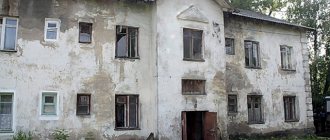Prices for lawyer services on housing issues
Recognizing housing as unsafe is a multi-stage procedure, during which signs of dilapidation and disrepair of housing facilities are identified, legally significant decisions are made with a view to the subsequent resettlement of such houses. To begin the process, it is necessary to establish signs that the house is unsuitable for citizens to live in.
The main signs of a house being in disrepair are related to its service life after construction or major repairs. Such signs include:
- Physical standard wear and tear of a building is calculated based on regulatory rules as a percentage of the condition of the structure at the time of construction.
- The actual wear and tear of the building is determined during the inspection of the capital elements of the structure.
Signs of emergency conditions are the basis for the creation of an interdepartmental commission to inspect the facility. The commission is created on the initiative of local governments and includes representatives of the owner of a residential property, officials of state and municipal housing control bodies, as well as a number of other persons.
The conclusion of the interdepartmental commission allows you to record the signs of a house's disrepair in a legally significant document - the conclusion of the commission. This conclusion will be the basis for a decision by the local government to recognize the house as unsafe.
3 ways to get a free legal consultation 01
-consultant in online chat bottom right
02
Free call 8 (free consultation in Russia)
03
Request a call back (bottom left button), a lawyer will call you back in 10 minutes
Free consultation with a lawyer on housing issues Prices for lawyer services on housing issues
Recognition of housing as unsafe
Reform of the housing and communal services system is carried out simultaneously in several directions: major repairs of apartment buildings, commissioning of housing for low-income citizens, recognition of housing as unsafe with the subsequent resettlement of citizens.
The implementation of these activities is a priority area of activity for the state. The deterioration of the state and municipal housing stock makes citizens increasingly ask the question: how can housing be recognized as unsafe?
Establishing the legal fact of accidents allows citizens to count on receiving new housing that meets all the requirements and standards of improvement and habitability.
Reasons
If a building's standard wear and tear exceeds the established standard of 70-80%, it is almost inevitable that it will be considered unsafe. How can housing be recognized as dilapidated or in disrepair when the physical wear and tear according to the documents is within acceptable limits, although the actual condition of the housing poses a threat of its destruction?
Owners and tenants of residential premises have the right to apply to the authorized bodies to inspect the property to determine whether it is dilapidated or unsafe.
This statement will be the basis for the creation of a commission that will assess the actual condition of the housing for suitability for habitation.
The provision of municipal services for the consideration of complaints and applications from citizens establishes the obligation of the local government body to respond to each fact of such appeal. The illegal inaction of these bodies to recognize this fact can be appealed by citizens to the prosecutor's office or in court.
If the interdepartmental commission, during its inspection, establishes the existence of grounds for recognizing the house as unsafe, it is obliged to reflect this fact in the conclusion, indicating the possible consequences:
- The house is subject to demolition and resettlement of citizens.
- the house is subject to reconstruction in order to return it to its normal physical condition.
Regardless of these consequences, the local government body is obliged to make a decision to recognize the housing as unsafe after receiving the commission’s conclusion.
What to do if there is delay on the part of the authorities?
Unfortunately, in such matters, displaced persons are often forced to wait months for new housing to be provided. And most often this state of affairs is due to the banal lack of residential premises among municipality representatives. True, in this case, you can still live in the old apartment for some time. No one will demolish the building until the last owner has checked out. The disadvantage lies, again, in the danger of such premises.
If it turns out that the move is constantly being postponed, you must write a written statement to the housing and communal services administration of your area with a request to clarify the situation. After which, within a month you should receive a response about the progress of the case. If it is not received, you need to write a statement addressed to the head of this administrative resource. After which, in most cases, the matter gets off the ground.
But when the second application does not bring tangible results, you can safely contact the city prosecutor’s office with a request to assist in resolving this difficult and vital situation.
Deadlines
From the moment the local government authority receives the commission’s conclusion, a decision must be made within 30 days to recognize the house as unsafe. This period is established by law and entails a number of legally significant consequences:
- The local administration is obliged to take measures to resettle citizens into new housing: draw up a priority list for resettlement, find funds to purchase apartments for resettlement, and resolve disputes with the owners of apartments in a dilapidated building.
- Residents of the house receive the right to demand their relocation from a house that is recognized as unsafe and subject to demolition or reconstruction.
If the local administration within 30 days has not made the indicated decision to recognize the property as unsafe, its inaction can be appealed in court at the suit of the residents of the dilapidated building or authorized supervisory authorities.
In what cases is the owner provided with new housing?
There are several objective reasons for the resettlement of owners of living space from dilapidated and dilapidated housing. These include:
- serious wear and tear of the entire structure, when it can collapse at any moment. And unfortunately, there are enough such cases in history;
- multiple non-compliances of the building with sanitary standards - both inside and outside;
- In addition, residential buildings located near seismically unstable areas, high-voltage power lines, noisy roads, and those that have ever been exposed to earthquakes, as well as similar natural and man-made emergencies, are subject to demolition.
Moreover, minor inconsistencies with sanitary and hygienic standards, such as the lack of an elevator, gas or hot water, are not yet a good reason for relocation and further demolition of such a structure.
Procedure
The procedure for relocating citizens from a house recognized as unsafe depends on the legal status of the residential premises located in this facility.
Tenants occupying apartments in official housing stock are required to provide new official or departmental housing. Relocation from these premises is carried out at the expense of the owner of the house or the local government body on whose territory the housing is located.
Tenants under open-ended social tenancy contracts are required to provide comfortable housing for relocation in accordance with established standards for the provision of residential premises that meet the requirements of livability and suitability for living.
Owners of apartments in a dilapidated building have several possible options:
- They have the right to agree to move to an apartment offered by the local administration.
- They have the right to refuse to receive such housing and demand payment of compensation for the market value of their apartments.
- They have the right to appeal the amount of compensation for the market value of the apartment.
Regardless of the status of the occupied premises, citizens have the right to demand their relocation from a dilapidated building.
Application for the provision of an apartment in exchange for another
Department of Housing Policy _________ __________________________
from __________________________ __________________________
STATEMENT
I, ________________-, live in an apartment with a total area of ____ sq.m., and a living area of ____ sq.m. by the address: ______________________. This apartment is my property based on the certificate of ownership No. ____________. In accordance with the Decree of the Moscow Government dated __________ No. ________ “On the resettlement and demolition of five-story buildings in the block ____ ___________ district, no.__, k.__ on the street. _________ is subject to resettlement and demolition. Since __________, we have learned that we are being provided with new living quarters with the vacancy of the occupied living space. Based on this Resolution, the Department of Housing Policy and Housing Fund provided us with two inspection coupons. Based on the first inspection coupon, we were offered a separate two-room apartment with a total area of ____ sq.m., including without balconies ____ sq.m., residential ____ sq.m., in a new building at the address: ___________________________ On my part, there was a refusal of the proposed option, since this living space was provided ___ m less than the area I currently have. I was then offered a second examination card. Based on the second coupon, residential premises were offered at the address: a separate 2-room apartment with a total area of ____ sq.m., including without a balcony ____ sq.m., residential ____ sq.m. by the address: ___________________. Those. in fact, my first refusal was recognized as legal and justified. However, I also could not agree with the second proposal for a number of reasons. Firstly, because on the basis of the second inspection card, I was provided with housing not in my area, or even nearby. And secondly, the second inspection coupon was issued before the __________ year, was sent without taking into account the delivery time, and was delivered only on the _________ year. It turns out that by the time it was received by mail, the deadline for making a decision was already 2 days overdue. Both options are unacceptable to me, as they significantly worsen my living conditions. The first significantly reduces my living space, and the second sends me far beyond my residence, where I have lived for more than 40 years. According to the Moscow Law “On ensuring the residential rights of citizens when relocating and vacating residential premises (residential buildings) in Moscow” Release of residential premises (residential buildings) is the legal and actual transfer of residential premises (residential building) free from any encumbrances and the rights of third parties, the city of Moscow or its authorized person. The release of residential premises (residential buildings) is carried out upon: 1) relocation of citizens from residential premises (residential buildings) to other residential premises in the manner established by this Law; 2) providing a gratuitous subsidy for the acquisition of ownership of residential premises or the construction of residential premises in order to acquire them into ownership; 3) provision of compensation in cash or redemption price. The resettlement of citizens from residential premises (residential buildings) in the city of Moscow is carried out by providing them with residential premises in replacement of those vacated in the manner established by this Law. The release of residential premises and the relocation of citizens from residential premises (residential buildings) are formalized by concluding appropriate contracts or agreements with the owners, tenants and users of residential premises. The release of residential premises (residential buildings) and the relocation of citizens from residential premises (residential buildings) in the city of Moscow are carried out on the grounds specified in federal legislation and this Law. When relocating from residential premises (residential buildings), as well as their vacancy, citizens have the right in the prescribed manner to: provision of comfortable residential premises under contracts of social tenancy, rental, free use or free subsidy for the acquisition of ownership of residential premises or the construction of residential premises for the purpose of acquiring them as property. Owners, tenants and users of residential premises when relocating and vacating residential premises (residential buildings) in the city of Moscow have the right to receive official information about the grounds, terms, conditions and procedure for relocating and vacating residential premises (residential buildings) in the city of Moscow, as well as protection of their rights when relocating and vacating residential premises (residential buildings) in the city of Moscow in accordance with federal legislation. According to Article 3 of this Law, citizens who vacate residential premises occupied by them under contracts of social tenancy, rental, free use, or to whom residential premises (residential buildings) belong by right of ownership, are provided with comfortable residential premises in the housing stock of the city of Moscow, respectively, under a social contract rental, hire, gratuitous use or ownership in the area of residence. Residential area is the territory limited by the external border of the districts of the city of Moscow adjacent to the district of the city of Moscow in which the residential building to be vacated is located. Moreover, these areas of the city of Moscow must be located in the same administrative district of the city of Moscow. The provision of residential premises outside the area of residence is carried out on the basis of a written application from citizens.
Based on the above and guided by the Law of the city __________ “On ensuring the residential rights of citizens during the relocation and vacancy of residential premises (residential buildings) in the city __________”
ASK:
1. Provide residential premises in the city of ________ with a living area no less than what is currently available and located in my area of residence. 2. Consider my application in the prescribed manner. Notify me of the results of consideration of the application in writing within the period prescribed by law. Please send the response to this application to the applicant’s place of residence, namely: ____________________
Appendix: 1. Copy of the certificate of ownership 2. Copy of the Extract from the house register 3. Copy of the financial and personal account 4. Copy of Letters from the housing estate of __________
«___»_______________ _____________
Where to go
To exercise their right to relocate housing, residents of a dilapidated building have the opportunity to contact the following authorities:
- To the municipality - to create an interdepartmental commission to recognize the house as unsafe.
- To the local administration - to include a dilapidated house in the resettlement program using funds from the Housing and Communal Services Reform Fund.
- To the local administration - for relocation from a house officially recognized as unsafe.
- To the prosecutor's office - to eliminate violations of the right to resettlement caused by illegal actions or inaction of officials.
- To institutions of state control and supervision in the field of housing law - to protect the right to decent living conditions that meet the requirements of norms and regulations.
- To the courts - to restore violated rights and forcibly provide housing for relocation from a dilapidated house.
To apply to each of these authorities, you must send an application accompanied by documents confirming the recognition of the fact that the building is in disrepair and the right to relocation.
How to apply for moving out of dilapidated housing
If the owner of the emergency area agrees to the proposed conditions, a corresponding agreement is concluded between him and representatives of local authorities. Which also includes the type of compensation provided - new space, or its monetary equivalent.
When a relocation agreement is concluded, as a rule, some time is allocated for preparatory procedures. In such cases, the displaced person is provided with a temporary place of residence or given financial compensation for renting an apartment.
. The same thing happens when moving into a new building.
The title documents for the new area are issued to the owner by the administrative authorities of the district. The department employee is given a 30-day period for this, which can be extended by another 1 month if necessary. When the papers are issued, the owner of the new living space should be registered at the new address.
Documentation
The main documents submitted by residents of a dilapidated building when protecting their rights include:
- Title documents for residential premises - lease agreements, extracts from the Unified State Register of Legal Entities, technical documentation.
- Documents confirming the unsuitability of housing for habitation - acts of inspection of living conditions, conclusion of an interdepartmental commission, technical documentation for a residential building.
- Decisions of local authorities on the issue of recognizing housing as unsafe, or refusing to recognize this fact.
The first step in the process of relocation from a dilapidated house will be an application for recognition of the dilapidation and disrepair of the object, which is submitted with the aim of creating an interdepartmental commission.
Sample application to the interdepartmental commission for recognizing houses as unsafe
SAMPLE APPLICATION To the interdepartmental commission for the assessment of residential premises on the territory of the Naumovsky rural settlement from _____________________________________________________ (indicate the status of the applicant - owner of the premises, tenant) _____________________________________________________ (last name, first name, patronymic of the citizen) _______________________________________________________ (passport details) _______________________________________________________ (address of residence and registration) _______________________________________________________ (contact telephone number) APPLICATION I request that you assess the compliance of the premises at the address: ______________________________________________________________________________ ______________________________________________________________________________ with the requirements established in the “Regulations on recognizing premises as residential premises, residential premises unsuitable for habitation and an apartment building as unsafe and subject to demolition”, approved by Decree of the Government of the Russian Federation of January 28, 2006 No. 47. The following must be attached to the application: 1. Notarized copies of title documents for residential premises_______________________________________________________________________________ 2.
Please note => Additional payment of 32% UBI in 2020
Plan of the living space with its technical passport as of “___”_____________3. Project for the reconstruction of non-residential premises (for recognition in the future as residential premises) on __________ sheets.4. Conclusion of a specialized organization conducting an inspection of this house (to recognize an apartment building as unsafe) dated “____”_____________20___.
Sample application
An application for dilapidated housing is submitted by citizens who legally live in a house that shows signs of disrepair. A sample application for recognizing a house as unsafe can be obtained from the local administration.
This application must be accompanied by documents confirming the right to legal residence in the specified house (lease agreement, certificate of ownership, etc.). In addition, documents are attached confirming the existence of grounds for recognizing the housing as unfit for habitation.
Sample application to the interdepartmental commission
To recognize a home as dilapidated, it is necessary to submit a corresponding application on behalf of the residents of the house to a certain organization. Based on this document, a special commission is created that resolves such issues. As a rule, it includes housing and communal services workers, BTI specialists, designers, representatives of executive authorities, etc.
— residential premises located in dangerous zones of landslides, mudflows, snow avalanches, as well as in territories that are annually flooded with flood waters and in which it is impossible to prevent flooding of the territory using engineering and design solutions should be considered unsuitable for living.
27 Apr 2020 yurisaktobe 308
Share this post
- Related Posts
- Is it possible to sell an apartment purchased with maternity capital?
- Buy a stamp about marriage and divorce
- List of Documents for Registration of Ownership of a House
- Status of low-income families 2020 Perm
Providing new housing
Recognizing housing as unsafe and providing new housing is the responsibility of state and municipal authorities. The legal fact of recognizing that a house is in disrepair allows one not only to count on possible relocation to new housing, but also provides the right to demand forced resettlement through the court.
Recognition of housing as unsafe
is the most important legally significant act that allows citizens living in dilapidated and dilapidated housing to obtain the right to state support measures.
Author of the article: Petr Romanovsky, lawyer Work experience 15 years, specialization - housing disputes, family, inheritance, land, criminal cases.
What is meant by dilapidated housing?
Under emergency and dilapidated housing, it is customary to understand private and municipal residential buildings with visible damage to load-bearing structures that threaten the life and health of the people living in them. A wooden structure receives emergency status in case of general wear and tear of 65%, and brick and block houses - if wear exceeds 70%. Therefore, when relocating owners of old houses, according to the law, they are entitled to living space that does not pose a danger to life and health.
Please note: it is unlikely that it will be possible to significantly improve the living space in this way, since the housing provided is often little better than the previous one and does not exceed it in area. But at least you don’t have to worry about the safety of your life.








